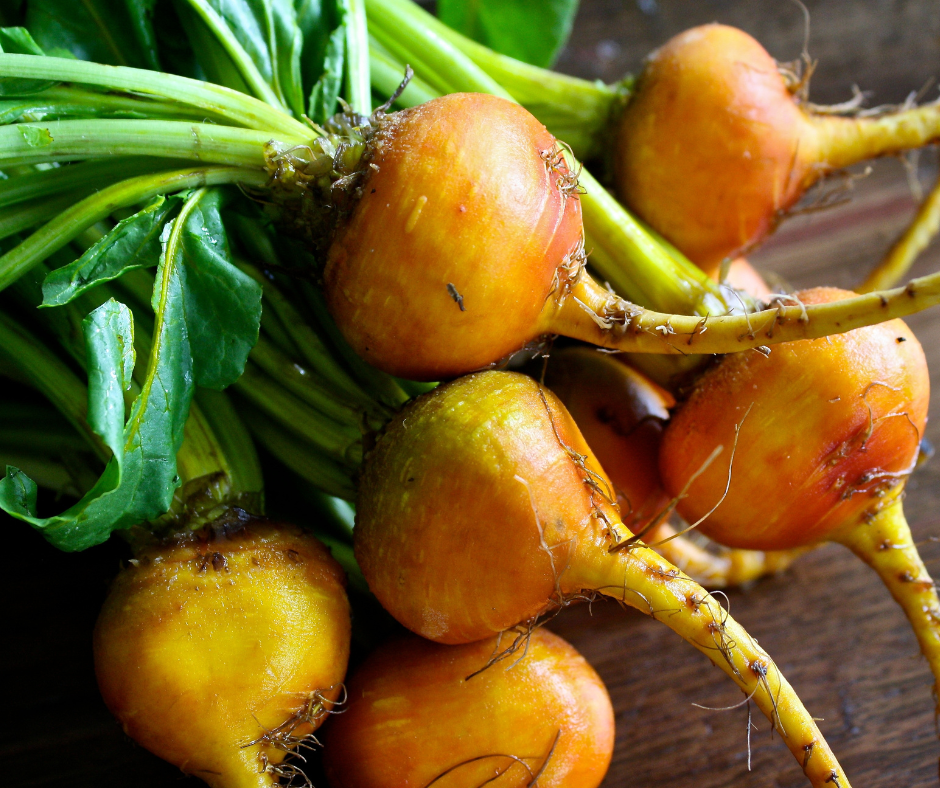Planting root vegetables, like beets, can be a rewarding and delicious experience for any gardener. They tend to be some of the easier vegetables to grow, making them great choices for teaching young gardeners. Late winter/early spring or mid fall are great times to plant root vegetables as they prefer a cooler temperature and will peter out quickly and decline in quality once the warmer temperatures. We’re talking beets today.
Have you ever roasted a fresh, homegrown beet? Have you ever crunched through a thin sliced beet in a fresh garden salad? I love beets. They can be prepared warm and savory, or cold, sweet and crisp. I think if you’ve had a less-than-positive opinion about beets, a homegrown taste might be your cure. (Unless you’re my aunt who you can never convince a beet doesn’t taste like dirt.) Let’s take a look at how to grow these jewel-toned beauties and see if you just might want to try planting some this month.


Beet Seeds vs. Beet Transplants
Although you may find some transplants of root vegetables at the nursery, it’s really best to plant these type of vegetables by direct seeding. The long taproot on veggies like beets, carrots, radishes, turnips, and kohlrabi, can easily get damaged in the process of transplanting. Direct seeding eliminates this problem. In this blog, we will explore some tips on how to grow some of these vegetables successfully.
Planting Beets for Spring
Timing is key. For spring, plant 4-6 weeks before the average last killing frost frost your location (First week or so of March, according to Farmer’s Almanac). Getting seeds in the ground now, means that beets will be maturing when daytime temps are in the low to mid 60’s. You get the best growth for roots and quality tops when beets are developing then.
You can continue to plant in succession in 2-3 week intervals to have a continual harvest throughout spring, but you probably shouldn’t be doing any planting past mid March. (You’ll risk ending up with bitter leaves and low quality roots.)
Planting Beets for Fall
Timing is also key during this season. For fall, you’ll want to wait to plant seeds until daytime temps are consistently around 80° or cooler. This usually happens mid to late September. We’re still aiming for that sweet spot of the beets coming into maturity a couple months later when avg. day temps are 60-65 degrees.


Soil for Beets
Beets thrive in well-draining soil with a pH level 6.5 or slightly above. Give yourself at least 12″ of soil depth (15″ is even better) to grow beets. Your growing attempts will be more successful by adding a lot of organic matter into your gardens. Organic matter allows for roots to grow more freely, and helps soil retain moisture and nutrients, as well as improving drainage. 2-3″ of organic matter like compost, living mulch, soil conditioner, worked into the top 10″ of your garden soil should be sufficient.
We like to add a complete, granular fertilizer (we like Espoma Garden-Tone) a few days before planting, scattering it over the planting area and working it into the soil. Watering your planting area a couple days before planting gives your seeds a nice moist start.
Planting Beets
Although not mandatory, soaking seeds in room temperature water the night before planting helps speed up the germination process. It takes a little longer for germination during early spring than when planting in fall (maybe up to 3 weeks).
Plant beet seeds in rows about 12 inches apart, and scatter 8-10 seeds along each foot of space. A trick of the trade is to cover the seeds with no more than an inch of either compost or potting soil. These products offer the best conditions for germination and seed emergence as well as preventing garden soil from crusting over the seeds. Lightly firm, or tamp down, soil to make sure the seed has good contact.


Thinning Beets
When plants have developed one or two sets of true leaves (not the cotyledons) and before they are 2″ tall, you need to thin your beets. Some people grow beets solely for greens, while other grow beets for both greens and roots (bulb). Thinning will depend on which you are growing.
- Greens only: thin plants to 3-4″ apart
- Greens and Roots: thin plants to 2″ apart.
When thinning seedlings that are really close together, it might be best to use the tip of sharp scissors to snip just below the soil line rather than pulling them up as you might disturb the root of the remaining plant.
Maintaining Beets
When beets are 6″ tall, feed them some nitrogen fertilizer (21-0-0). A recommended amount and application method from Dr. Sam Cotner in The Vegetable Book, is ½ cup for every 35 feet of row. Offer half the fertilizer along each side of the row about 4-6″ from the beets and water in thoroughly.
Mulch beets after this fertilization with 1-2″ of organic mulch (we like Living Mulch). , Calculate in rainfall or lack of rainfall so you can keep your garden beds from drying out. The soil should be moist but not soggy.


Harvesting Beets
In general, but depending on variety, you can expect beets to be ready to harvest within a range of 55 to 80 days after planting.
If harvesting for greens only, you should be able to start picking around 6 weeks after planting. For beet harvesting, the best quality will be when the beets are pulled before they are more than 2″ in diameter.
Happy beet planting!
~The Happy Gardener, Lisa Mulroy


Can you plant beets in large planters? I have 3 large planters that housed elephant ears & vincas, approximately 22″
Absolutely you can plant beets in containers. We often use grow bags for beets, carrots, turnips, etc… Just follow the same advise for thinning to give enough room for full sized bulbs to develop. Good luck!